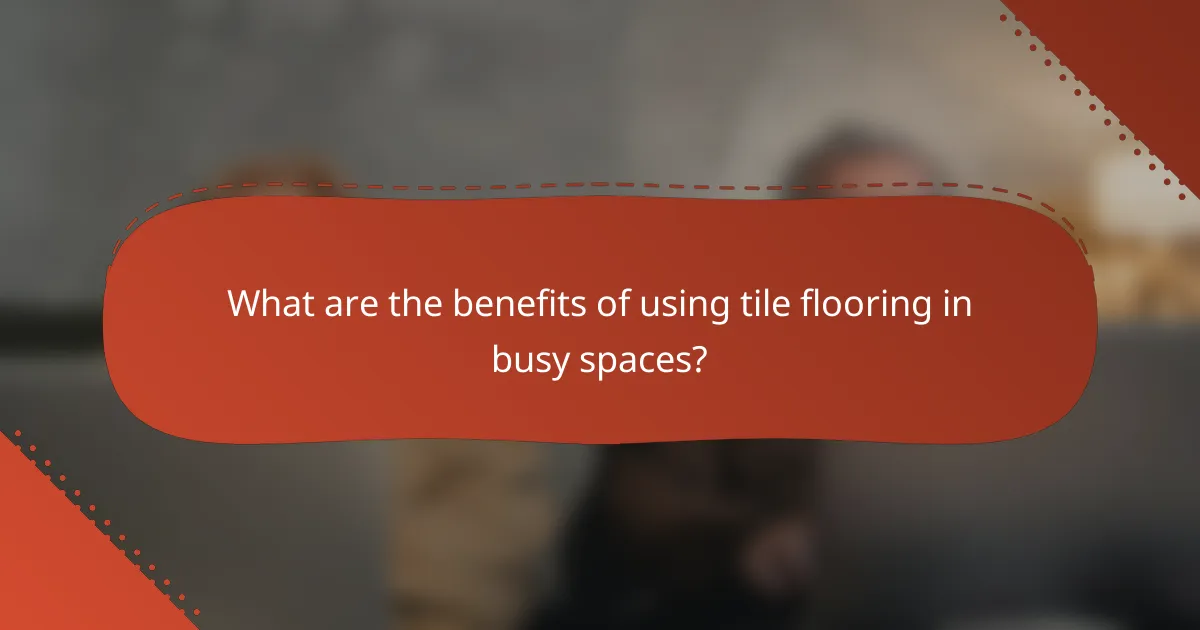When selecting flooring for high-traffic areas, durability is paramount to ensure long-lasting performance and aesthetic appeal. Options such as luxury vinyl plank, tile, engineered hardwood, laminate, and carpet tiles each provide unique advantages tailored to withstand heavy use. By considering factors like foot traffic and moisture exposure, you can choose the best material to enhance both functionality and style in your space.

What are the best durable flooring options for high-traffic areas?
The best durable flooring options for high-traffic areas include materials that can withstand heavy use while maintaining their appearance and functionality. Key choices are luxury vinyl plank, tile flooring, engineered hardwood, laminate flooring, and carpet tiles, each offering unique benefits and considerations.
Luxury Vinyl Plank (LVP)
Luxury vinyl plank (LVP) is a popular choice for high-traffic areas due to its resilience and water resistance. It mimics the look of natural wood or stone while being easier to maintain and install.
LVP is available in various styles and colors, allowing for customization to match any decor. Its durability makes it suitable for both residential and commercial spaces, often lasting over a decade with proper care.
Tile Flooring
Tile flooring is exceptionally durable and resistant to scratches, stains, and moisture, making it ideal for high-traffic zones like kitchens and entryways. Ceramic and porcelain tiles are common choices, with porcelain being denser and less porous.
When selecting tile, consider slip resistance, especially in wet areas. Installation can be labor-intensive, but the longevity and easy maintenance make it a worthwhile investment.
Engineered Hardwood
Engineered hardwood combines a real wood veneer with a plywood base, providing a durable alternative to solid hardwood. It can handle fluctuations in humidity better than traditional wood, making it suitable for various climates.
This flooring type offers the aesthetic appeal of hardwood while being less prone to warping. With proper care, engineered hardwood can last for many years, making it a good option for busy households.
Laminate Flooring
Laminate flooring is an affordable and durable option that replicates the look of wood or stone. It consists of multiple layers, including a protective top layer that resists scratches and fading, making it suitable for high-traffic areas.
While laminate is easy to install and maintain, it is less water-resistant than some other options, so it’s best used in areas where spills are less likely. Choosing a high-quality laminate can enhance its durability and lifespan.
Carpet Tiles
Carpet tiles offer a versatile flooring solution that combines comfort with durability. They are easy to install and replace, making them ideal for high-traffic areas where wear and tear are common.
Available in various colors and patterns, carpet tiles can be arranged in creative designs. They provide sound insulation and warmth but may require regular cleaning to maintain their appearance in busy spaces.

How do I choose durable flooring for my home in urban areas?
To choose durable flooring for your home in urban areas, consider factors like foot traffic, moisture exposure, and maintenance needs. Selecting the right materials can enhance longevity and performance in high-use environments.
Consider foot traffic levels
Foot traffic levels significantly influence the choice of flooring. In urban homes, areas like entryways, hallways, and living rooms often experience high foot traffic, necessitating tougher materials. Options such as luxury vinyl, tile, and engineered hardwood are popular for their resilience.
When assessing foot traffic, think about the specific activities in each area. For instance, kitchens may require more durable surfaces due to spills and heavy use, while bedrooms can accommodate softer options.
Evaluate moisture resistance
Moisture resistance is crucial in urban settings where humidity and spills are common. Flooring materials such as porcelain tile, vinyl, and certain laminates offer excellent moisture resistance, making them suitable for kitchens and bathrooms.
Consider the climate in your area as well. If you live in a region with high humidity, prioritize flooring that can withstand moisture without warping or mold growth. Always check the manufacturer’s specifications for water resistance ratings.
Assess maintenance requirements
Maintenance requirements vary widely among flooring options, impacting long-term satisfaction. Some materials, like natural stone or hardwood, may need regular sealing or refinishing, while others, like vinyl or laminate, require minimal upkeep.
When selecting flooring, think about your lifestyle. If you have pets or children, choose materials that are easy to clean and resistant to scratches. A quick maintenance checklist can help: opt for floors that can be swept or mopped easily and avoid those that stain easily.

What are the benefits of using tile flooring in busy spaces?
Tile flooring offers numerous advantages for high-traffic areas, including exceptional durability, ease of maintenance, and a wide variety of design options. These features make tile an ideal choice for spaces that experience significant foot traffic, such as entryways, kitchens, and commercial settings.
High durability and scratch resistance
Tile flooring is renowned for its high durability and scratch resistance, making it suitable for busy environments. Most tile options can withstand heavy foot traffic without showing signs of wear, which is essential for maintaining a professional appearance in commercial spaces.
Additionally, many tiles are made from materials like porcelain or ceramic, which are less prone to scratching compared to softer flooring options. This resilience helps to preserve the flooring’s aesthetic appeal over time, reducing the need for frequent replacements.
Easy to clean and maintain
Cleaning tile flooring is straightforward, requiring only regular sweeping and occasional mopping to keep it looking fresh. The non-porous surface of many tiles prevents stains from setting in, making spills easy to manage.
For high-traffic areas, consider using a mild detergent and warm water for cleaning. Avoid harsh chemicals that may damage the tile’s finish. Regular maintenance can extend the life of the flooring and keep it hygienic, which is especially important in spaces like kitchens and bathrooms.
Variety of design options
Tile flooring comes in a vast array of colors, patterns, and textures, allowing for customization to fit any design aesthetic. From classic ceramic tiles to modern porcelain and natural stone options, there is a tile to suit every taste.
When selecting tile for a busy space, consider both style and functionality. For example, larger tiles can create a seamless look and reduce grout lines, while textured tiles can enhance slip resistance. This variety enables homeowners and businesses to create visually appealing environments without sacrificing durability.

How does luxury vinyl plank compare to laminate flooring?
Luxury vinyl plank (LVP) and laminate flooring are both popular choices for high-traffic areas, but they have distinct differences. LVP is generally more water-resistant and durable, making it a better option for spaces prone to moisture and heavy use.
Water resistance of luxury vinyl plank
Luxury vinyl plank is designed to be highly water-resistant, often featuring a waterproof core that prevents moisture damage. This makes LVP suitable for areas like kitchens and bathrooms where spills are common.
In contrast, laminate flooring can be susceptible to water damage if spills are not cleaned promptly. While some laminate products offer water-resistant features, they typically do not match the level of protection provided by LVP.
Cost differences between LVP and laminate
Luxury vinyl plank tends to be more expensive than laminate flooring, with prices generally ranging from $2 to $7 per square foot, depending on quality and brand. Laminate flooring usually costs between $1 to $4 per square foot, making it a more budget-friendly option.
While LVP has a higher upfront cost, its durability and water resistance can lead to lower long-term maintenance costs, especially in high-traffic or moisture-prone areas.
Durability in high-traffic areas
Both luxury vinyl plank and laminate flooring are designed to withstand wear and tear, but LVP often outperforms laminate in high-traffic environments. LVP is typically more resistant to scratches, dents, and stains, which is crucial in busy households or commercial spaces.
Laminate flooring can show signs of wear more quickly, especially in areas with heavy foot traffic. Choosing a high-quality laminate can improve its durability, but it may still require more frequent replacement compared to LVP.

What factors affect the lifespan of flooring in high-traffic areas?
The lifespan of flooring in high-traffic areas is influenced by several key factors, including the quality of materials, installation methods, and regular maintenance practices. Understanding these elements can help you choose the right flooring and extend its durability.
Quality of materials used
The quality of materials directly impacts how well flooring withstands wear and tear in high-traffic areas. Durable options like luxury vinyl, tile, and hardwood are often better suited for heavy use compared to cheaper alternatives. Investing in higher-quality materials can lead to a longer lifespan and reduced replacement costs over time.
Look for flooring products that meet industry standards for durability, such as those rated for commercial use. These materials are typically designed to resist scratches, dents, and stains, making them ideal for busy environments.
Installation methods
Proper installation is crucial for maximizing the lifespan of flooring in high-traffic areas. Floors that are poorly installed may develop issues like buckling, gaps, or uneven surfaces, which can lead to premature damage. Hiring a professional installer with experience in high-traffic applications can ensure that the flooring is laid correctly and securely.
Consider the type of flooring when selecting installation methods. For example, glue-down installations may be more suitable for vinyl in commercial spaces, while floating floors might work better for hardwood in residential settings. Always follow the manufacturer’s guidelines for installation to achieve optimal results.
Regular maintenance practices
Regular maintenance is essential for prolonging the lifespan of flooring in high-traffic areas. This includes routine cleaning, periodic deep cleaning, and timely repairs of any damage. Establishing a maintenance schedule can help prevent dirt buildup and wear that can shorten the life of your flooring.
Implement simple practices such as using mats at entryways to reduce dirt and moisture, and promptly addressing spills to prevent staining. Additionally, consider refinishing hardwood floors every few years or applying sealants to tile and vinyl surfaces to enhance their durability.

What are the installation costs for durable flooring in metropolitan areas?
The installation costs for durable flooring in metropolitan areas can vary significantly based on the type of material, labor rates, and local market conditions. Generally, you can expect to pay anywhere from a few dollars to over twenty dollars per square foot, depending on the flooring choice and complexity of the installation.
Average cost of tile installation
The average cost of tile installation typically ranges from $5 to $15 per square foot, including both materials and labor. Factors influencing this cost include the type of tile selected, the size of the area, and any necessary preparation work.
For example, ceramic tiles are generally less expensive than natural stone tiles, which can significantly increase your overall expenses. Additionally, intricate patterns or layouts may require more labor, thus raising the installation cost.
When budgeting for tile installation, consider potential extra costs such as underlayment, grout, and sealants. It’s advisable to obtain multiple quotes from local contractors to ensure competitive pricing and to clarify what is included in the estimate.
